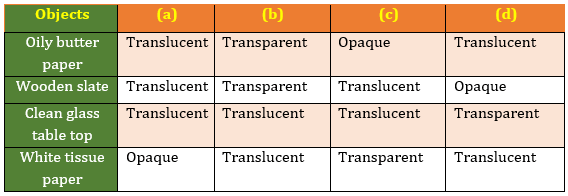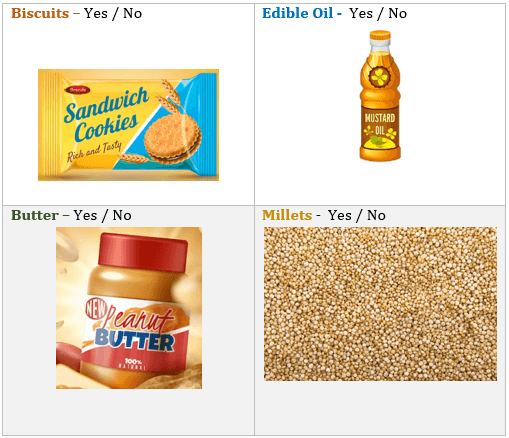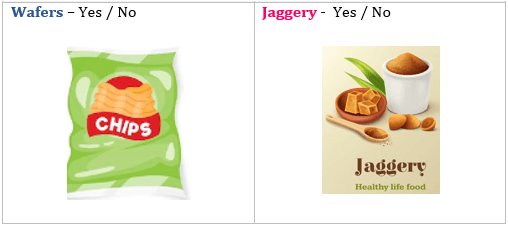Sorting Materials Into Groups Worksheet
Objective Type Questions
- Match the objects in Column A with appropriate characteristics given in column B:
- State whether the following statements are true or false. In case of false statement, write the correct one.
(i) Materials which can be compressed or scratched easily are called translucent materials.
(a) True
(b) False
(ii) Materials which generally have lustre are called plastics.
(a) True
(b) False - Find odd one out from the following with reason:
(a) Apricot, Peach, Jasmine, Pomegranate, Raspberries.
(b) Nilgiri, Godavari, Satpura, Shivalik, Girnar
Multiple Choice Questions - Teacher asked Nilay to tick mark the items which can be made without utilizing metal at all. Help Nilay to choose the item/s.
(a) Both A and E
(b) Only D
(c) Only C
(d) Both B and C - An experiment was conducted in Asmi’s classroom with different sheets to check transparency. A source of light was observed through these four sheets.
Sheet 1: Oily butter paper
Sheet 2: Wooden slate
Sheet 3: Clean glass
Sheet 4: White tissue paper
Which of the following is correct? - Below given table shows two sorted groups labelled as Group A and Group B. Which option correctly lists other objects that can be included in Group A and Group B?
(a) Group A: Plastic tiffin box, Group B: Apple
(b) Group A: Furry toy, Group B: Cow
(c) Group A: Silver spoon, Group B: Rice
(d) Group A: Apple, Group B: Gold ring - Mugdha says that a woolen ball is harder than a plastic doll and a glass bowl is tougher than a steel bowl. On examining these materials, what can be correctly said about them?
(a) It is easier to break a steel bowl than a glass bowl.
(b) It is easier to compress woollen balls than plastic dolls.
(c) The glass bowl is easier to break than the steel bowl.
(d) The glass bowl tears up more easily than the woollen ball. - Sevanthi dropped a coin, a plastic scale and a stone in a bucketful water. Which of these would sink or float?
(a) Stone and plastic scale would sink but coin would float.
(b) Coin and stone would sink and plastic scale would float.
(c) Plastic scale and coin would float, but stone would sink.
(d) All of three would sink. - Sunil tried to dissolve a spoonful of sand, salt and sugar in a glass of water. Which of the following would be observed?
(a) Only salt and sand are soluble in water.
(b) Only sugar and sand are soluble in water.
(c) Only salt and sugar are soluble in water.
(d) All three are soluble in water. - Which of the following objects would show luster?
(a) Clay kadhai
(b) Wooden ship
(c) Steel furniture
(d) Plastic bucket - The materials which can NOT be used by milk seller for milk delivery is:
(a) Cloth bag
(b) Plastic bag
(c) Steel container
(d) Glass bottle
Case Study Questions - At home, we usually store things in such a manner that similar objects are placed together. Such an arrangement helps us to locate them easily. Similarly, a grocer usually keeps all type of biscuits at one corner of his shop, all soaps at another while grains and pulses are stored at some other place.
(a) What is meant by sorting?
(b) What is the need of sorting?
(c) How sorting helps the shopkeeper? - When you press different materials with your hands, some of them may be hard to compress while others can be easily compressed. On the other hand, there are some materials through which you are not able to see. Shopkeepers usually prefer to keep biscuits, sweets and other eatables in transparent containers.
(a) Why shopkeepers keep the eatables in transparent materials?
(b) Name two compressible and non-compressible materials each.
(c) Distinguish between opaque, transparent and translucent materials along with an example for each.
Subjective Questions - On birthday evening, Vidya could cut the cake with knife easily but she faced difficulty in breaking walnuts gifted by her Dadi. What conclusion can be made by this?
- Identify properties and write Yes/No accordingly.
- Comment: Frosted glass cannot be used for front window of any four wheeler.
- Kasturi enjoying her summer vacation was asked by her mother to sort out weekly grocery just delivered to her house from nearby grocery store. Which of these need to be stored in the refrigerator? Write Yes or No in front of their names.
- Adwait tried to get back lustre by rubbing below objects with sand paper. Which of the following objects cannot regain their lustre upon being rubbed with sandpaper and why?
Tarnished copper mug, dusty ceramic cutlery, rusted iron nails, silver diya, tinted plastic table top.
Assertion Reasoning Questions
Below questions consist of two statements – Assertion (A) and Reason (R). Answer these questions selecting the appropriate option given below: - Assertion (A): The greasy patch on the butter paper is termed as translucent.
Reason (R): Translucent materials are those through which objects can be viewed but not clearly. - Assertion (A): Some materials float on the surface of the water, while others sink.
Reason(R): The materials which are difficult to compress are called hard.
Explore more Science Sample papers and Solutions
- Components Of Food Worksheet
- Separation Of Substances Worksheet
- Getting To Know Plants Worksheet
- Body Movements Worksheet
- The Living Organisms – Characteristics and Habitats Worksheet
- Motion And Measurement Of Distances Worksheet
- Light, Shadows And Reflections Worksheet
- Electricity and Circuits Worksheet
- Fun With Magnets Worksheet
- Air Around Us Worksheet
-
Competency Based Questions for CBSE Class 6 Science
-
Sample Papers for CBSE Class 6 Science Term 1 #1
- Sample Papers for CBSE Class 6 Science Term 1 #2
-
Sample Papers for CBSE Class 6 Science Term 2 #1
- Sample Papers for CBSE Class 6 Science Term 2 #2

































